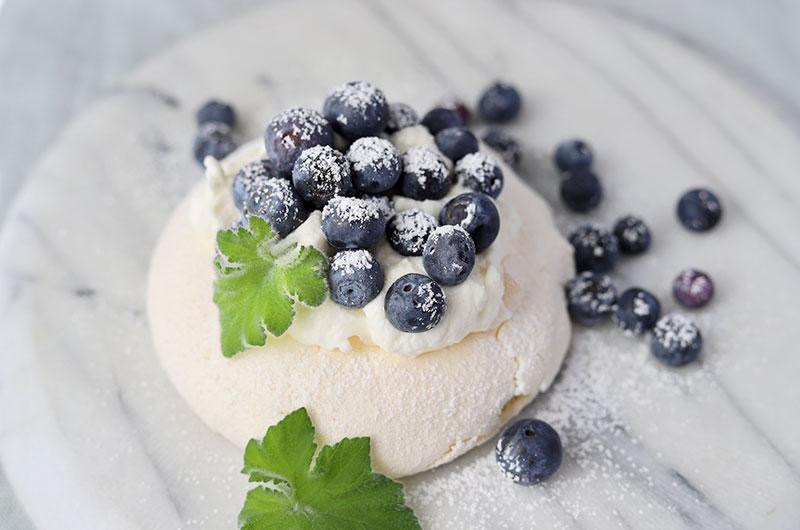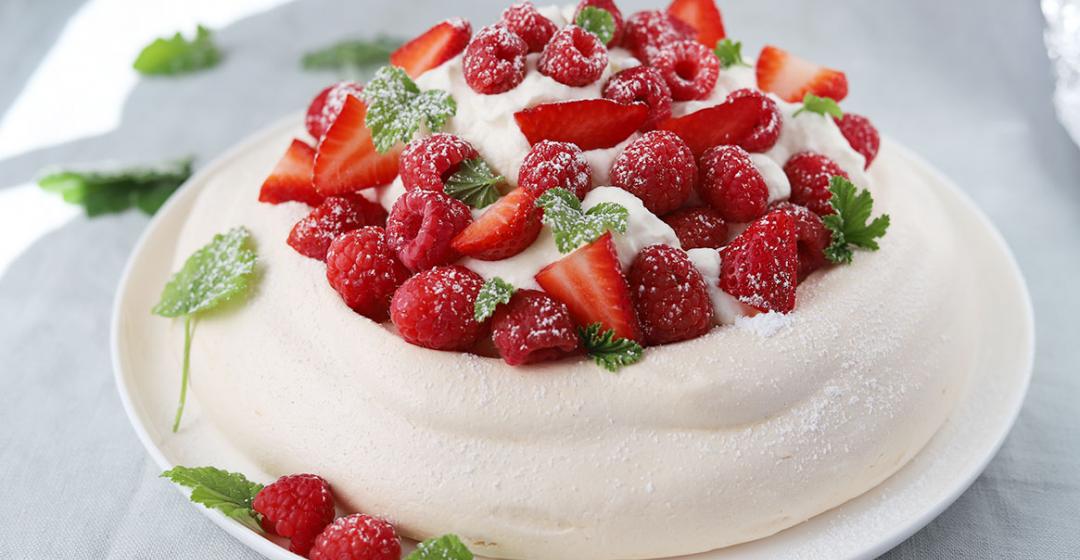Since flour and yeast are off-limits for the Passover holiday, this impressive meringue cake (sometimes known as a Pavlova) is ideal as it's made with whipped egg whites and sugar and baked until crisp. The filling is whipped cream and berries or other fruit, and the final result is gorgeous.
Making meringue can be a little tricky, so we’ve included some tips below. Be sure to read them before you start if it has been awhile since you’ve made a meringue. Take note that the recipe calls for superfine sugar, but if you don’t have it on hand you can simply place regular granulated sugar into a blender or food processor and whirl for a few minutes to break down the crystals.
Once you’ve whipped up the meringue, you spoon it onto a parchment-lined baking sheet in an 8-inch circle, using the back of a spatula or spoon to make an indent in the meringue. The meringue bakes for 1 1/2 hours but then sits in the turned-off oven for several hours or overnight so plan your time accordingly.
Meringue cakes look stunning filled with seasonal berries like strawberries, blueberries and raspberries, but you can also use pineapple chunks, citrus slices, or whatever seems right to you. You can also top the cake with toasted coconut flakes. Garnishes of mint leaves or other edibles and/or a dusting of powdered sugar are optional.

You can also use this meringue to make individual "mini" cakes. They won't have quite the same pillowy texture inside as the larger cake, but will still be delicious.
Editor's note: If you are keeping Kosher for Passover, or want to prepare a vegan version of this dessert, consider using whipped coconut cream in place of the whipped cream.
Serves 4 to 6
For the meringue cake:
- 1/2 vanilla bean, optional *
- 1 1/4 cups superfine sugar or regular sugar (about 250 g), whizzed in food processor
- 5 egg whites, cold (about 150 ml)
- Pinch Kosher salt
- 1 tablespoon lemon juice
For the cream and berries filling:
- 1 cup whipping or heavy cream
- 2 tablespoons sugar
- 1/2 vanilla pod, optional*
- About 2 to 2 1/2 cups fresh strawberries or any fruit you have, cut into small pieces
- 1/2 cup unsweetened coconut flakes, toasted (optional)
- Mint leaves or other edible garnishes (optional)
- Confectioners’ sugar (optional)
*Vanilla extract is not used during Passover since it contains alcohol
1. Preheat the oven to 225 degrees. Put a sheet of parchment paper on a heavy-duty rimmed baking sheet or cookie sheet; you can add a dab of butter to the bottom of the paper to hold it in place. Using a pencil and an overturned bowl or plate as a template, lightly draw an 8-inch circle in the middle of the parchment; set aside.
2. Cut the vanilla bean in half lengthwise (if using) and, use a small, sharp knife to scrape the seeds out. Place the sugar in a bowl and add the vanilla seeds and mix to distribute.
3. In the bowl of a standing mixer using the whip attachment, beat the egg whites and the salt on medium-low speed until frothy, about 1 minute. Increase the speed to medium-high and beat until soft peaks form, about 1 ½ to 2 minutes. Add the sugar very gradually, sprinkling one tablespoon at a time into the bowl, continuing to beat on medium-high (not high), until the meringue is glossy and holds soft peaks, a total of about 3 minutes. You can stop the mixer once or twice during this time to scrape down the sides (sugar that is not dissolved or combined can cause the meringue to weep later, so be sure it is all mixed in). Add the lemon juice and beat just until combined, about another minute.
4. Using a spoon or soft spatula, carefully spread the meringue mixture into the marked circle. You don’t need to be overly precise. Use your silicon spatula or spoon to create a slight indent in the center (which will later be filled with whipped cream and fruit), pushing the meringue mixture out away from the center towards the sides.
5. Put the pan on the middle shelf in the oven and bake for 1 1/2 hours, or until the meringue feels crisp and dry on the outside. (Do not open the oven door frequently). Turn off the oven (and oven light if on) and keep the meringue in the turned-off oven for about 2 to 3 hours to dry out further and so that it cools down very slowly; it can stay in the oven overnight.
6. When totally cool, remove from the oven and carefully remove the meringue from the parchment paper and put it on a cake stand or serving plate.
7. Just before you are ready to serve the cake, use an electric mixer to whip the cream and vanilla in a bowl until soft peaks form. Add the sugar and whip until stiff peaks just form — be careful not to overwhip the cream.
8. Fill the middle of the meringue cake with the whipped cream and arrange the fruit and coconut (if using) on top. Do not add the cream and fruit to the cake more than 15 to 20 minutes before serving. Cut with a large, sharp knife.
Tips for Making Meringue
1. Humidity is not a friend of meringue. If it’s rainy or a particularly humid day be sure to keep all your equipment and ingredients cold. And you will need to keep the meringue in the oven for a minimum of 3 hours to properly dry out.
2. Be sure all of your equipment – ingredient bowls, mixer, whisk, spatulas, etc., are very clean (use a little vinegar to wipe down the mixing bowl and whisk.)
3. If you don’t have superfine sugar, measure regular granulated sugar out first, then put it into the food processor and blitz it until superfine (but not powdery).
4. Separating egg whites from yolks is much easier while the eggs are very cold. But after separating, if you’ve got time, let them come to room temperature, as they will then whisk better.
5. If possible, use the weight and volume given in the recipe for your sugar and egg whites. Measuring the volume of the five egg whites (you want about 150 to 155 ml) is an especially good idea if using local Vineyard eggs, which tend to vary in size. Use a Pyrex glass measure..
6. While making the meringue, do your best to make sure all the sugar is dissolved and well incorporated into the whites, as undissolved sugar crystals can cause the meringue to weep in the oven. Scrape the bottom and sides of the bowl a couple times during mixing if necessary.
7. Use any leftover meringue to form mini meringue cookies by placing a tablespoon dollop on the prepared parchment alongside the cake.
8. Use an oven thermometer to check the temperature of your oven; some ovens run very hot and ideally your meringue will cook best at 225F. (But don’t worry if the meringue turns slightly golden during cooking, it will still be good.)
Kathy Gunst is a James Beard award-winning food journalist and author of 16 cookbooks. Her latest book, co-authored with Katherine Alford, is Rage Baking—The Transformative Power of Flour, Fury and Women’s Voices. She is the Resident Chef for NPR’s Here and Now and has been coming to the Vineyard for 47 years.







